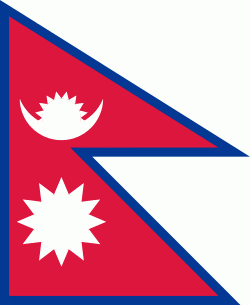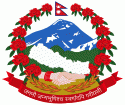Ramechhap District (Ramechhap District)
Ramechhap District (रामेछाप जिल्ला), a part of Bagmati Province, is one of the seventy-seven districts of Nepal, a landlocked country of South Asia. The district, known as wallo Kirat Ramechhap, with Manthali as its district headquarters, covers an area of 1,546 km2 and has a population (2011) of 202,646 and a density of 137.4 per km2.
According to LLRCNepal there are now eight local administrations in the district: Manthali Municipality, Ramechhap Municipality, Umakunda Rural Municipality, Khandadevi Rural Municipality, Gokulganga Rural Municipality, Doramba Rural Municipality, Likhu Rural Municipality and Sunapati Rural Municipality.
The district has the highest population of the endangered native group the Kusunda and has the lowest population growth rate in Nepal.
The district was named after Ramechhap village. The word Ramechhap comes from two Nepali words, Ram (person's name) and Chhap (mark). According to folklore, the village of Ramechhap was once occupied by Tamang people. A Tamang of the village, Ram by name received mukhtiyari of the village by royal decree. So, the land ownership and other legal activities were performed in the village by the stamp (chhap) of Ram.
Similarly, according to another folklore, the grassland of Ramechhap village was occupied by Tamang people. Those people daily used to rear their domesticated animals such as Buffalo, Goat and others in the open meadow. In Tamang language, "Ra" means Goat, "Mey" means ox, and "Chhawa" means their small offspring. By the time and mouth to mouth pronunciation the meadow has become "Ramechhap" and later the place has been named Ramechhap. Hence, the district is called Ramechhap.
According to LLRCNepal there are now eight local administrations in the district: Manthali Municipality, Ramechhap Municipality, Umakunda Rural Municipality, Khandadevi Rural Municipality, Gokulganga Rural Municipality, Doramba Rural Municipality, Likhu Rural Municipality and Sunapati Rural Municipality.
The district has the highest population of the endangered native group the Kusunda and has the lowest population growth rate in Nepal.
The district was named after Ramechhap village. The word Ramechhap comes from two Nepali words, Ram (person's name) and Chhap (mark). According to folklore, the village of Ramechhap was once occupied by Tamang people. A Tamang of the village, Ram by name received mukhtiyari of the village by royal decree. So, the land ownership and other legal activities were performed in the village by the stamp (chhap) of Ram.
Similarly, according to another folklore, the grassland of Ramechhap village was occupied by Tamang people. Those people daily used to rear their domesticated animals such as Buffalo, Goat and others in the open meadow. In Tamang language, "Ra" means Goat, "Mey" means ox, and "Chhawa" means their small offspring. By the time and mouth to mouth pronunciation the meadow has become "Ramechhap" and later the place has been named Ramechhap. Hence, the district is called Ramechhap.
Map - Ramechhap District (Ramechhap District)
Map
Country - Nepal
 |
 |
| Flag of Nepal | |
The name "Nepal" is first recorded in texts from the Vedic period of the Indian subcontinent, the era in ancient Nepal when Hinduism was founded, the predominant religion of the country. In the middle of the first millennium BC, Gautama Buddha, the founder of Buddhism, was born in Lumbini in southern Nepal. Parts of northern Nepal were intertwined with the culture of Tibet. The centrally located Kathmandu Valley is intertwined with the culture of Indo-Aryans, and was the seat of the prosperous Newar confederacy known as Nepal Mandala. The Himalayan branch of the ancient Silk Road was dominated by the valley's traders. The cosmopolitan region developed distinct traditional art and architecture. By the 18th century, the Gorkha Kingdom achieved the unification of Nepal. The Shah dynasty established the Kingdom of Nepal and later formed an alliance with the British Empire, under its Rana dynasty of premiers. The country was never colonised but served as a buffer state between Imperial China and British India. Parliamentary democracy was introduced in 1951 but was twice suspended by Nepalese monarchs, in 1960 and 2005. The Nepalese Civil War in the 1990s and early 2000s resulted in the establishment of a secular republic in 2008, ending the world's last Hindu monarchy.
Currency / Language
| ISO | Currency | Symbol | Significant figures |
|---|---|---|---|
| NPR | Nepalese rupee | ₨ | 2 |
| ISO | Language |
|---|---|
| EN | English language |
| NE | Nepali language |















